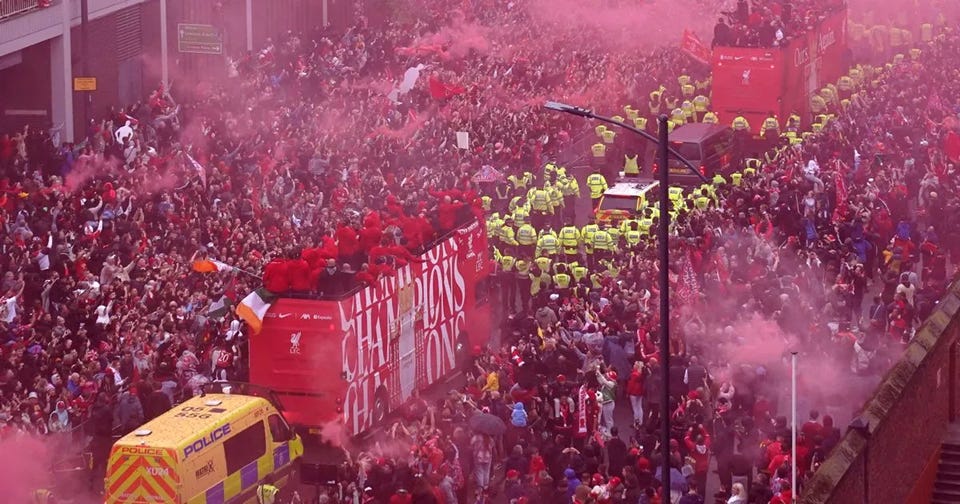Liverpool Football Victory Parade Turns From Jubilance to Horror
As working men’s clubs, trades unions, and the great religions, Christianity and socialism, have faded in Britain, football has remained as virtually the only communal pillar of life and identity in many areas. Liverpool is a prominent example. The victory of Liverpool Football Club (LFC) in the Premier League this season has been, Everton fans notwithstanding, a cause of city-wide celebrations since it was mathematically confirmed at the end of April. The celebrations culminated yesterday with the team’s parade through the city.
The intensity of the feelings around this season’s win—there were an estimated one million people on the streets in Liverpool yesterday—can be explained by two factors. First, LFC was once the dominant team in English football: in the eighteen seasons from 1972 to 1990, they—we—won the league eleven times. It has been a long wait since then. Second, the one exception in the last thirty-five years, LFC winning the Premier League in 2019-20, was overshadowed by the COVID-19 pandemic, which delayed fixtures and then prevented any public celebration. A lot of the pent-up emotions that would have been released five years ago are being released now.
In this context, the disruption of yesterday’s proceedings by a car driving into a crowd has had an impact beyond the wounding of forty-seven people. Apart from anything else, many people, myself included, had family and friends there. The incident happened just after 18:00 on Water Street, one of the roads off the Strand in front of the Liver Buildings, where my aunty and young nephew were standing. A friend of my brother’s was stood at the top of Water Street, one-hundred yards from the impact. The sense of “there but for the grace of God” is widespread today, mingled with sadness for those affected, anger at the man responsible, and a bitterness that such a happy occasion ended this way.
The facts about what happened are reasonably straightforward:
A car drove into a crowd. From the clips that circulated, it does not seem likely it was accidental: the driver seems to have turned the car to target a larger concentration of pedestrians. One eyewitness who was nearly hit said the driver had “no intention—it appeared—of stopping”, but was forced to by a parked ambulance.
Of the forty-seven wounded, twenty were treated at the scene. Twenty-seven were treated at hospital, including four children, and there were two seriously injured people, one of them a child, who had been trapped under the car.
A 53-year-old white British man from the Liverpool area has been arrested. Police say they “believe him to be the driver of the vehicle.” As the car was stopped by the irate crowd, and police quickly surrounded it to prevent the driver being lynched, there cannot be much ambiguity about who was responsible here.
There are, of course, many remaining questions, even about the mechanics of the attack. As highlighted by Liverpool City Metro Mayor Steve Rotheram this morning, one of the outstanding questions is how the car got on to Water Street at all, since that route was “blocked off”.
The other obvious mystery is what motivated the apparent attacker. Police have announced that they are not treating the incident as terrorism, meaning they have not discovered a political, religious, racial, or other ideological cause behind the ramming attack, but that raises as many questions as it answers. Do police mean merely that they have not discovered such a motive yet? Or have they discovered the motive and it is non-terrorist in nature? In which case, what is it?
The investigation is still in its early stages, so it will take time to get answers.
UPDATE (29 MAY 2025): After three days of questioning, the attacker was named as Paul Doyle when seven charges were filed against him: two counts of unlawful and malicious wounding with intent to cause grievous bodily harm (GBH); two counts of causing unlawful and malicious GBH with intent to cause GBH; two counts of attempted, unlawful and malicious GBH with intent to cause GBH; and one count of dangerous driving. Six victims were named in the indictment, two of them children, aged 11 and 17. Doyle will appear in court tomorrow and his plea hearing will be on 14 August.
Various biographical details are now known:
Mr Doyle, a businessman and data security expert lives in the West Derby area of Liverpool. He and his wife have three children, and bought their four-bed detached house in 2017 for £192,000.
After serving in the Royal Marines for four years between 1990 and 1994, he graduated with a BSc in Psychology & Maths from the University of Liverpool in 1998.
Mr Doyle worked as a network security engineer and manager in the private sector and the NHS, going on to set up a firm called Farout Caps, which he ran as a retail mail order venture from his home. The business is currently listed as dormant after being dissolved in 2018 with assets of just £1,000.
He is a sports and fitness fan who has taken part in triathlons and enjoys travelling with his wife and children, with pictures on his social media pages showing him in Disneyland, Japan and Australia. … His wife is understood to be a Sunday school teacher.


